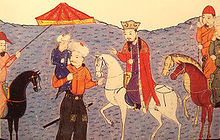
The ancient history of Afghanistan, also referred to as the pre-Islamic period of Afghanistan, dates back to the prehistoric era and the Helmand civilization around 3300–2350 BCE. Archaeological exploration began in Afghanistan in earnest after World War II and proceeded until the late 1970s during the Soviet–Afghan War. Archaeologists and historians suggest that humans were living in Afghanistan at least 50,000 years ago, and that farming communities of the region were among the earliest in the world. Urbanized culture has existed in the land from between 3000 and 2000 BC. Artifacts typical of the Paleolithic, Mesolithic, Neolithic, Bronze, and Iron ages have been found inside Afghanistan.

The Silk Road was a network of Eurasian trade routes active from the second century BCE until the mid-15th century. Spanning over 6,400 kilometers, it played a central role in facilitating economic, cultural, political, and religious interactions between the East and West. The name "Silk Road", first coined in the late 19th century, has fallen into disuse among some modern historians in favor of Silk Routes, on the grounds that it more accurately describes the intricate web of land and sea routes connecting Central, East, South, Southeast, and West Asia as well as East Africa and Southern Europe.

The Sarvāstivāda was one of the early Buddhist schools established around the reign of Ashoka. It was particularly known as an Abhidharma tradition, with a unique set of seven Abhidharma works.
An Shigao was an early Buddhist missionary to China, and the earliest known translator of Indian Buddhist texts into Chinese. According to legend, he was a prince of Parthia, nicknamed the "Parthian Marquess", who renounced his claim to the royal throne of Parthia in order to serve as a Buddhist missionary monk in China.

Hulegu Khan, also known as Hülegü or Hulagu, was a Mongol ruler who conquered much of Western Asia. Son of Tolui and the Keraite princess Sorghaghtani Beki, he was a grandson of Genghis Khan and brother of Ariq Böke, Möngke Khan, and Kublai Khan.

Greco-Buddhism or Graeco-Buddhism denotes a supposed cultural syncretism between Hellenistic culture and Buddhism developed between the 4th century BC and the 5th century AD in Gandhara, in present-day Pakistan and parts of north-east Afghanistan. While the Greco-Buddhist art shows clear Hellenistic influences, the majority of scholars do not assume a noticeable Greek influence on Gandharan Buddhism beyond the artistic realm.

The Ilkhanate or Il-khanate, also known as the Ilkhanids, and known to the Mongols as Hülegü Ulus, was a Mongol khanate established from the southwestern sector of the Mongol Empire. The Ilkhanid realm was officially known as the land of Iran or simply Iran. It was established after Hülegü, the son of Tolui and grandson of Genghis Khan, inherited the West Asian part of the Mongol Empire after his brother Möngke Khan died in 1259.
The history of Buddhism can be traced back to the 5th century BCE. Buddhism arose in Ancient India, in the modern day Lumbini, and is based on the teachings of the renunciate Siddhārtha Gautama. The religion evolved as it spread from the northeastern region of the Indian subcontinent throughout Central, East, and Southeast Asia. At one time or another, it influenced most of Asia.
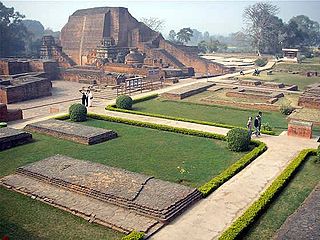
Buddhism, which originated in India, gradually dwindled and was replaced by approximately the 12th century. According to Lars Fogelin, this was "not a singular event, with a singular cause; it was a centuries-long process."
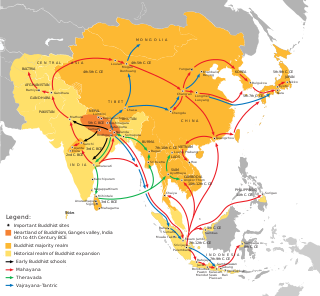
Buddhism entered Han China via the Silk Road, beginning in the 1st or 2nd century CE. The first documented translation efforts by Buddhist monks in China were in the 2nd century CE via the Kushan Empire into the Chinese territory bordering the Tarim Basin under Kanishka. These contacts transmitted strands of Sarvastivadan and Tamrashatiya Buddhism throughout the Eastern world.

Buddhism is the largest religion in Mongolia practiced by 51.7% of Mongolia's population, according to the 2020 Mongolia census. Buddhism in Mongolia derives much of its recent characteristics from Tibetan Buddhism of the Gelug and Kagyu lineages, but is distinct and presents its own unique characteristics.
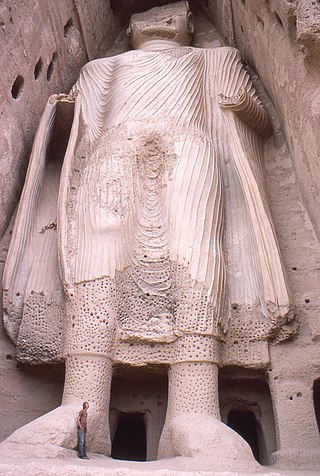
Buddhism, a religion founded by Gautama Buddha, first arrived in modern-day Afghanistan through the conquests of Ashoka, the third emperor of the Maurya Empire. Among the earliest notable sites of Buddhist influence in the country is a bilingual mountainside inscription in Greek and Aramaic that dates back to 260 BCE and was found on the rocky outcrop of Chil Zena near Kandahar.

Buddhist art is visual art produced in the context of Buddhism. It includes depictions of Gautama Buddha and other Buddhas and bodhisattvas, notable Buddhist figures both historical and mythical, narrative scenes from their lives, mandalas, and physical objects associated with Buddhist practice, such as vajras, bells, stupas and Buddhist temple architecture. Buddhist art originated in the north of the Indian subcontinent, in modern India, Pakistan and Afghanistan, with the earliest survivals dating from a few centuries after the historical life of Siddhartha Gautama from the 6th to 5th century BCE.
Many adherents of Buddhism have experienced religious persecution because of their adherence to the Buddhist practice, including unwarranted arrests, imprisonment, beating, torture, and/or execution. The term also may be used in reference to the confiscation or destruction of property, temples, monasteries, centers of learning, meditation centers, historical sites, or the incitement of hatred towards Buddhists.

Buddhism is an ancient Indian religion, which arose in and around the ancient Kingdom of Magadha, and is based on the teachings of Gautama Buddha who was deemed a "Buddha", although Buddhist doctrine holds that there were other Buddhas before him. Buddhism spread outside of Magadha starting in the Buddha's lifetime.

Buddhism in Central Asia mainly existed in Mahayana forms and was historically especially prevalent along the Silk Road. The history of Buddhism in Central Asia is closely related to the Silk Road transmission of Buddhism during the first millennium of the common era.
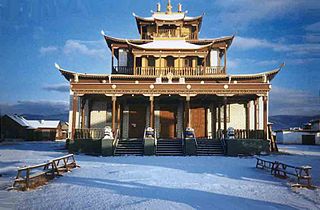
Historically, Buddhism was incorporated into Siberia in the early 17th century. Buddhism is considered to be one of Russia's traditional religions and is legally a part of Russian historical heritage. Besides the historical monastic traditions of Buryatia, Tuva and Kalmykia, the religion of Buddhism is now spreading all over Russia, with many ethnic Russian converts.

The Mongols were highly tolerant of most religions during the early Mongol Empire, and typically sponsored several at the same time. At the time of Genghis Khan in the 13th century, virtually every religion had found converts, from Buddhism to Eastern Christianity and Manichaeanism to Islam. To avoid strife, Genghis Khan set up an institution that ensured complete religious freedom, though he himself was a Tengrist. Under his administration, all religious leaders were exempt from taxation, and from public service. Mongol emperors were known for organizing competitions of religious debates among clerics, and these would draw large audiences.
Buddhists, predominantly from India, first actively disseminated their practices in Tibet from the 6th to the 9th centuries CE. During the Era of Fragmentation, Buddhism waned in Tibet, only to rise again in the 11th century. With the Mongol invasion of Tibet and the establishment of the Mongol Yuan dynasty (1271–1368) in China, Tibetan Buddhism spread beyond Tibet to Mongolia and China. From the 14th to the 20th centuries, Tibetan Buddhism was patronized by the Chinese Ming dynasty (1368–1644) and the Manchurian Qing dynasty (1644–1912) which ruled China.
Buddhism is a minor religion in Armenia, with a small but unknown number of adherents. The first direct contacts of Armenians with Buddhism occurred in the 13th century during the height of the Mongol Empire, culminating in the foundation of a Buddhist monastery in Armenia by Hulegu Khan of the Ilkhanate. Contacts recurred elsewhere in subsequent centuries through Armenian merchants. In the 19th and early 20th centuries, Armenian intellectuals developed a strong interest in the religion.
